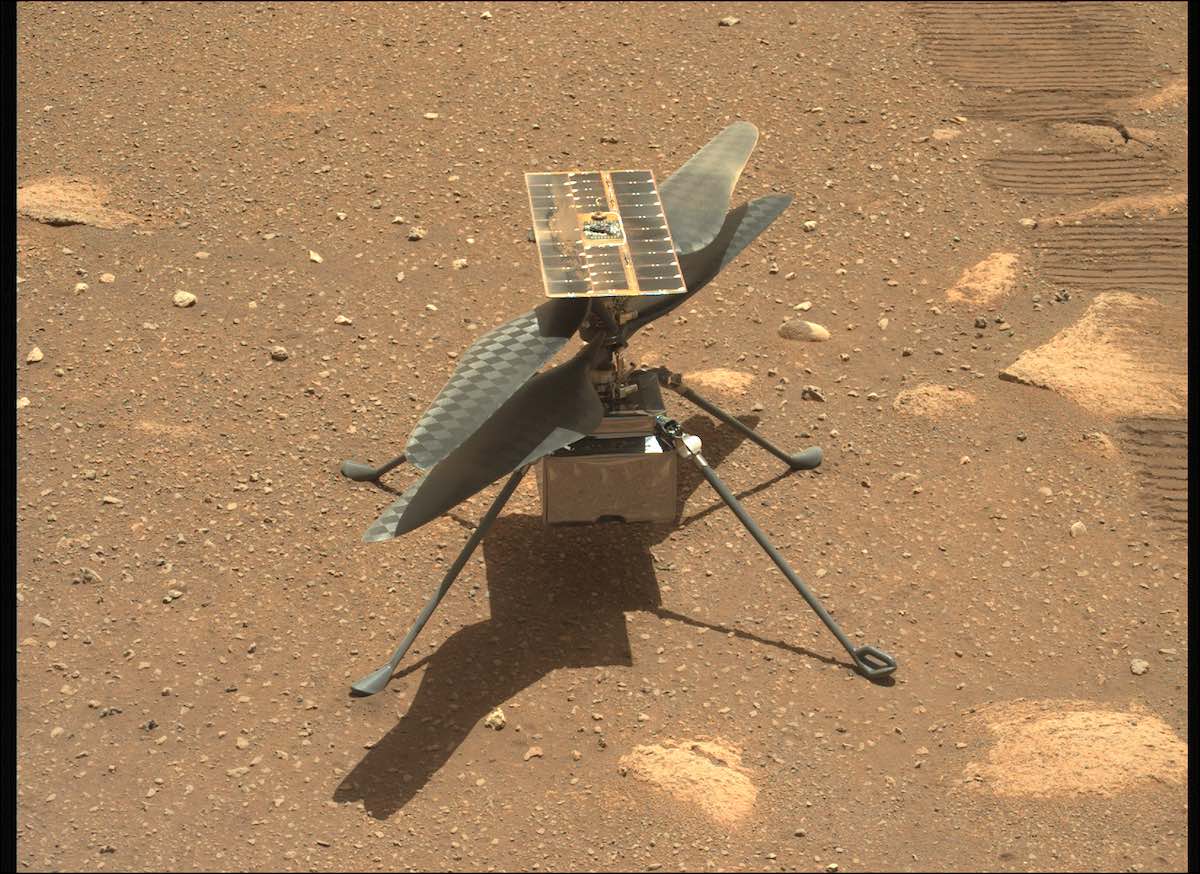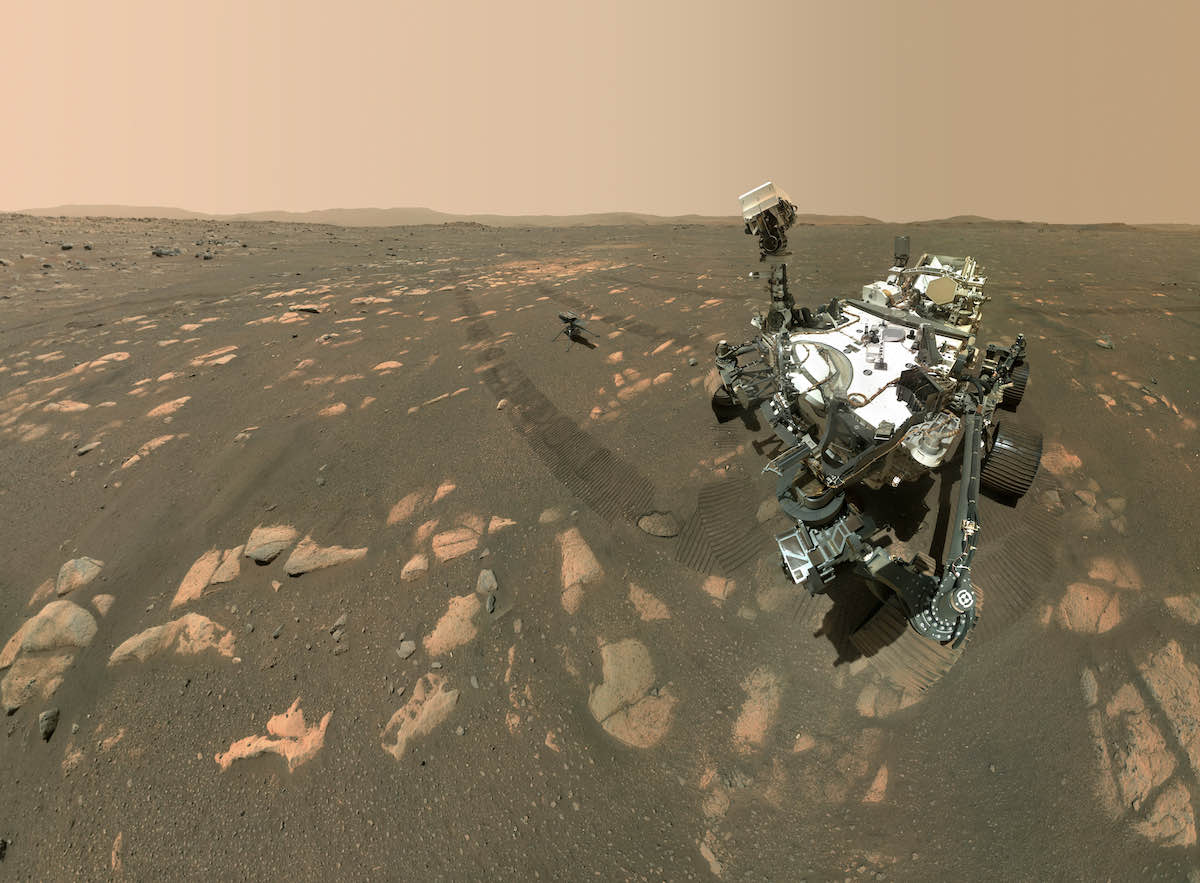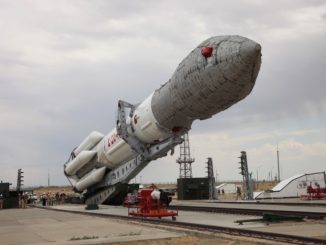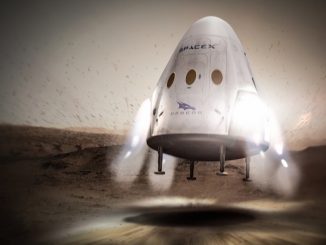After some long-distance troubleshooting, NASA’s Ingenuity Mars helicopter will attempt the first flight of its kind on another world Monday in a demonstration that could open the door to a new era of interplanetary aerial scouts.
Engineers at NASA’s Jet Propulsion Laboratory in California uplinked commands for Ingenuity’s test flight Sunday, setting the stage for takeoff on a brief up-and-down hop at 3:31 a.m. EDT (0731 GMT) Monday.
It will take nearly three hours for ground teams to receive data confirming the outcome of the flight. The signals will bounce from the helicopter to the Perseverance rover, which released the drone onto the Martian surface April 3, then to a orbiter flying overhead to relay the data back to Earth.
NASA TV will broadcast live coverage from JPL’s operations center beginning at 6:15 a.m. EDT (1015 GMT) Monday as officials await data on the results of Ingenuity’s hop. Once the data starts flowing, engineers will analyze the signals for the telltale signature the the helicopter took and landed successfully.
Then images will start streaming back to Earth from cameras on-board Ingenuity, and cameras on the Perseverance rover observing the flight from a range of about 200 feet (60 meters).
NASA officials expect the fully automated flight Monday to last around 40 seconds as the drone takes off to an altitude of about 10 feet (3 meters), momentarily hovers there, then rotates to point in a different direction before landing back on its four carbon-fiber legs.
The first images from the helicopter’s black-and-white navigation camera could come back to Earth soon after the test flight Monday. Then the craft will go to sleep and recharge its batteries before transmitting color images.
Meanwhile, a zoomed-in high-definition camera on the Perseverance rover’s mast will try to capture still images and video of the helicopter flight.
“We’re really excited,” said Tim Canham, Ingenuity’s operations lead at JPL. “It could be an amazing day. We’re all nervous, but we have confidence that we put in the work and the time, and we have the right poeple to do the job.”

If the first flight is as successful as NASA hopes, Ingenuity could fly four more times in subsequent weeks, trying more daring flight profiles before wrapping up the test flight campaign early next month. Then NASA wants to free up Perseverance to continue on its primary science mission of finding and collecting Martian rock samples for eventual return to Earth.
Lori Glaze, head of NASA’s planetary science division, described the Ingenuity helicopter as a “high-risk, high-reward” experiment that could pave the way for future aerial vehicles to explore Mars and other planets.
The $80 million Ingenuity helicopter has a mass of just 1.8 kilograms. It weighed 4 pounds on Earth, or 1.5 pounds in Martian gravity, but its lightweight blades will have to generate lift in an atmosphere less than 1% the density of Earth’s at sea level.
Bobby Braun, director of planetary science at JPL, said the helicopter and its support team back on Earth will attempt to produce a “Wright brothers’ moment” on another world.
Recognizing Ingenuity’s flight as another aviation first, NASA installed a postage stamp-size piece of fabric from the Wright brothers’ first aircraft, known as the Flyer, onto the Mars helicopter. The fabric covered one of the aircraft’s wings during its first flight at Kitty Hawk, North Carolina, on Dec. 17, 1903.
Another piece of fabric and a fragment of spruce wood from the Wright Flyer flew to the moon on the Apollo 11 mission in 1969. While the Wright brothers used fabric and wood for their aircraft, Ingenuity is made of carbon-fiber skins and “exotic metals,” said Bob Balaram, Ingenuity’s chief engineer at JPL.
Thomas Zurbuchen, head of NASA’s science division called Ingenuity’s first flight attempt “a historic moment the likes of which have analogs in 1903 — controlled flight on a different planet.”
Since Perseverance deployed the Ingenuity helicopter from its belly earlier this month, the rotorcraft has proven it can recharge its batteries using a solar panel, and keep warm in the frigid Martian night. Ground teams also sent commands to unlock the rotor blades, spanning nearly 4 feet (1.2 meters) tip-to-tip, for a low-speed spin test of 50 rpm.
But a problem cut short the drone’s rotor startup sequence on Mars during an attempted high-speed spin-up April 9. The rapid spin test of Ingenuity’s counter-rotating blades was supposed to be a final checkout before officials moved on to the helicopter’s first flight, then scheduled for April 11.
The command sequence for the high-speed spin test ended early as the helicopter was trying to transition the flight computer from “pre-flight” to “flight” mode, according to NASA. A watchdog timer system designed to oversee the command sequence expired before the completion of the spin test, prematurely ending the helicopter’s spin test.
Teams at JPL have devised two tactics to resolve the command sequence problem. One approach involves adjusting the command sequence to “slightly alter the timing” of the helicopter’s transition from pre-flight to flight mode, according to MiMi Aung, Ingenuity’s project manager.
The other solution is move disruptive and would further delay the helicopter’s first flight. That option is to reinstall modified software into Ingenuity’s flight computer, replacing code that had worked perfectly for the helicopter for nearly two years, Aung wrote in a post on NASA’s website.
Trying the flight using the altered command sequence is easier, and it worked Friday during a successful high-speed spin test of the helicopter’s rotors to near 2,500 rpm. Testing shows that solution will allow the helicopter to switch to flight mode and take off on 85% of attempts.
“We also know that if the first attempt does not work on Monday, we can try these commands again, with good probability that subsequent tries in the days following would work even if the first doesn’t,” Aung wrote. “For these reasons, we’ve chosen to pursue this path.”

In the meantime, teams on Earth continue to pursue the backup option of updating Ingenuity’s software. The new software has already been uplinked to the Perseverance rover, which could transmit the code to Ingenuity through the rover-to-helicopter wireless communications link if required.
“If our initial approach to flight does not work, the rover will send the new flight control software to the helicopter,” Aung wrote. “We will then require several additional days of preparation to load and test the new software on Ingenuity, redo the rotor tests in this new configuration, and recycle for a first flight attempt.”
Aung compared the test flight attempt to a rocket launch.
“We’re doing everything we can to make it a success, but we also know that we may have to scrub and try again,” she wrote. “In engineering, there is always uncertainty, but this is what makes working on advanced technology so exciting and rewarding. We have to continually innovate and develop solutions to new challenges. And we get to try things others have only dreamed of.”
“Ingenuity is a technology experiment,” Aung wrote. “As such, our plan is to push the envelope and learn by doing. We take risks that other missions cannot, weighing each step carefully.”
If everything works, the carbon-fiber rotors will spin at nearly 40 times per second to lift the Ingenuity helicopter off the ground. The rotor blades themselves have a mass of just 35 gains, or a weight of a little over 1 ounce, and they have to spin faster than helicopter rotors on Earth.
“A rotorcraft flies by generating lift,” Aung said. “On Earth it’s by pushing air, so the blades push the air and the lift is generated. On Mars, where the atmospheric density is so thin — about 1% compared to here — there are less molecules basically to push. So that means that we have to compensate … We have to spin so much faster than we do on Earth.”
The super-light weight of the helicopter, coupled with lightning fast control algorithms to adjust the craft’s flight 500 times per second, required advanced materials and computing capability.
“We just couldn’t do it 15 or 20 years ago, ” Aung said.
Email the author.
Follow Stephen Clark on Twitter: @StephenClark1.



